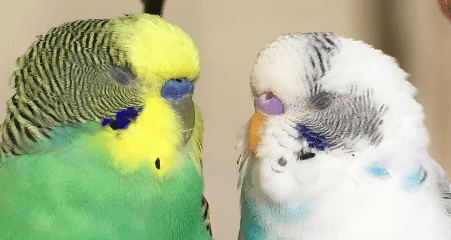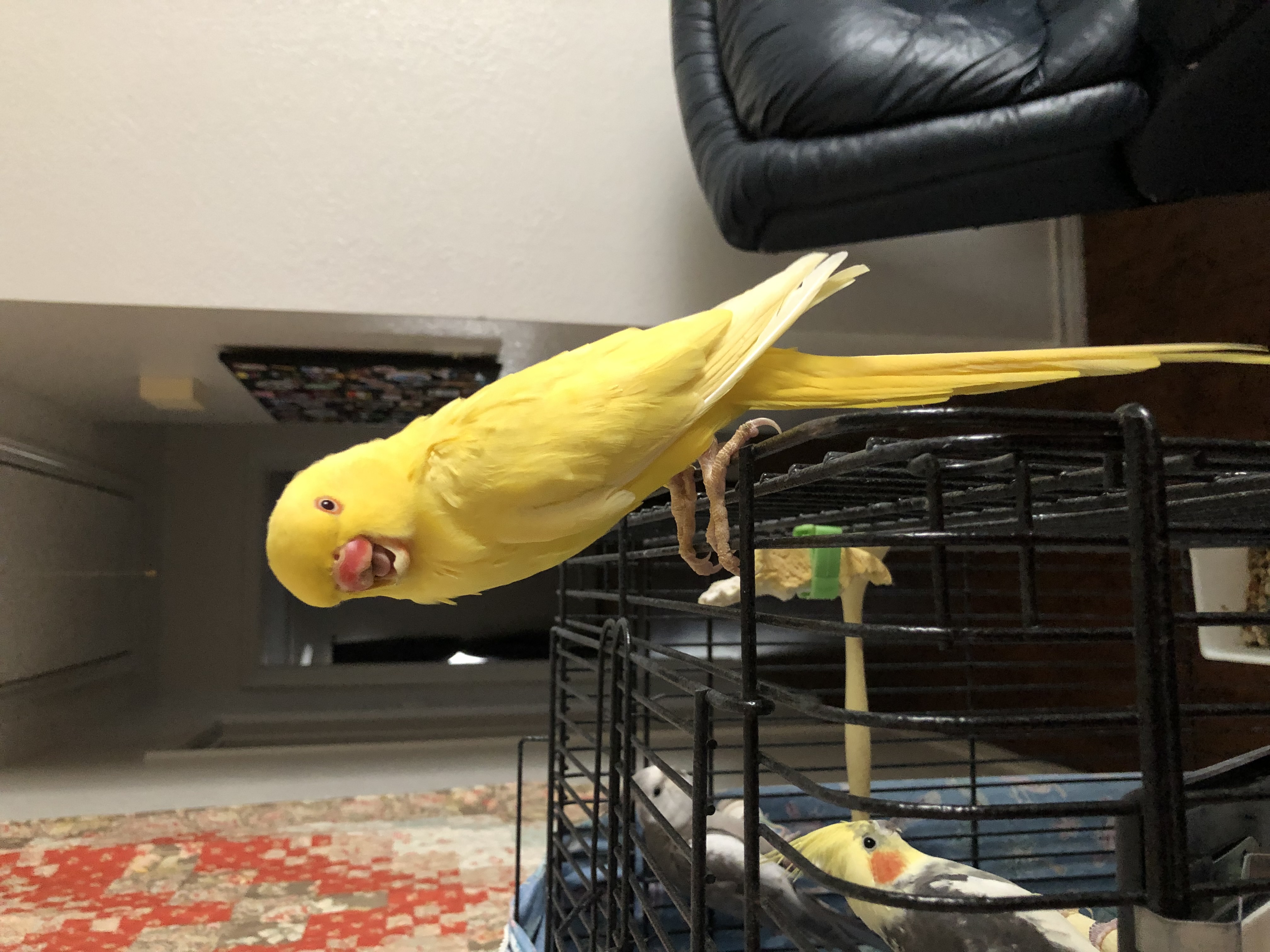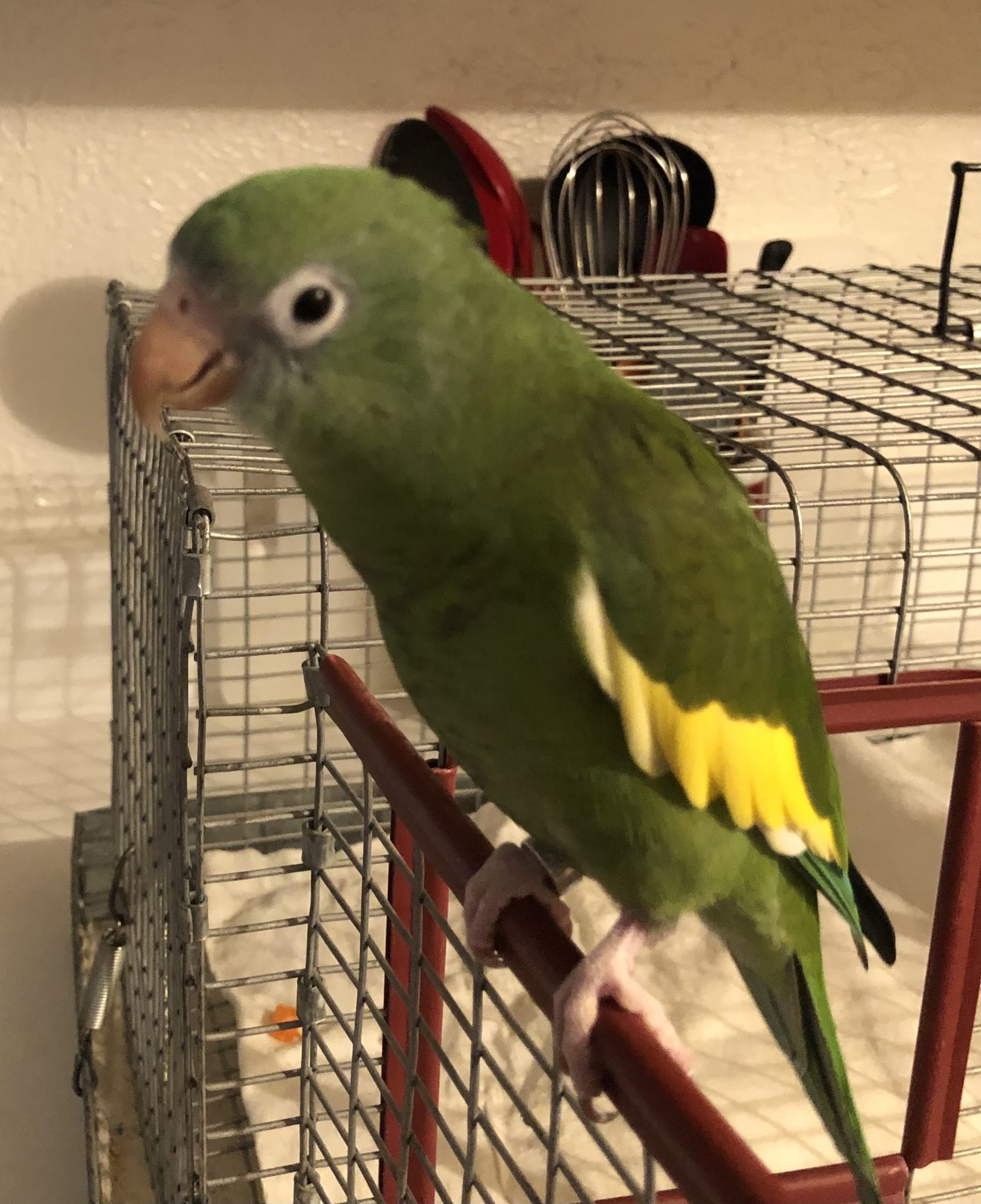Long before I began working with the Sanctuary, I did what I now know is the unthinkable, I bought a parakeet at a retail store. The store was run by bird breeders and I chose a little white one with a pretty blue underbelly, who put his little beak up to the window I was looking through.
Stuffed in a tiny Chinese takeout box, he rode home with me in the car, scolding and chirping. “It’s okay, birdie, we’ll be home soon,” I promised. Birdie, as a name, seemed a little too abbreviated though so I added a repeat, to give him some dignity, and called him Birdie, Birdie. And so the name stuck.
This little bird was charming. Still young, he had joy in his heart, and quickly imprinted on me. There was a problem, though. He couldn’t fly straight. Instead he flew in a circle to the left, like he was on a chain. I called the breeder, who assumed I wanted to return him. He told me, “If you bring him back, we will just use him for breeding.”
Although a life of love didn’t sound all that bad, I had already developed an attachment to him and decided to teach him to fly. It wasn’t all that hard, he just needed practice. And practice we did, round and round the bedroom until he learned to fly to me wherever I stood.
By the end of the lessons, we were best friends. Birdie Birdie’s cage was in my office next to my desk. Being in the middle of writing a book, I spent a lot of time there. To keep him off the keyboard while I was typing, my husband built him a perch that ensured the two of us were eye to eye while I worked. He loved watching my fingers type and, sometimes, it became just too much for him. He would fly down to the keyboard and chase my fingers while they danced across the keys. I would shoo him gently away, he’d squawk his displeasure, and then jump back on the keyboard. We both loved the game.
I talked to him as I worked, often asking if he wanted food to which he would answer, “Peep,” like he knew what I was saying. Then we’d go downstairs to the frig, break off a piece of broccoli, his favorite, from a plastic bag, wash it, and take it back upstairs to attach it to his perch for nibbling.
After following this routine for several weeks, Birdie took it upon himself to initiate the procedure. “Wanna go get you some food, Birdie Birdie?” he would say in a tiny but clear voice. Then he’d answer himself and say “Peep,” meaning ”of course.” I’d pick him up to carry him downstairs and by the time I opened the frig, he was making the exact sound of plastic rustling, then the snap of the broccoli sprig, and last, just before I turned the faucet on, he made the sound of the water flowing.
Birdie loved to hang upside from my bangs and gently peck me on the eyelids. Even though it didn’t hurt, it was annoying and I would warn him not to bite me. So of course within weeks he was hanging upside down in my face, looking me straight in the eyes threatening, “Don’t you bite mama.”
After several months he had absorbed nearly 30 different phrases that he heard from me frequently. Then one day, I heard a phrase I’d never said myself. Birdie had put words together meaningfully to make a new sentence. This was the first time I realized that he
really knew what he was saying when he talked. And this convinced me that birds do have language skills beyond mimicry.
He was clever and he loved playing tricks. If my daughter, who was afraid of birds, came over, he saw his chance to terrorize and he took it. He loved to dive bomb her and hear her scream, then he’d land on his cage, bop his little head up and down and laugh, “ha,ha, ha.” Of course, his laugh sounded just like mine, which didn’t help the situation any.
Parakeets have a brain that is smaller than a pea, yet they have been known to use up to 300 phrases. Most people see them as throw-away pets and we got a lot of them at the Sanctuary just because of that. In truth, they are smart little guys and make wonderful companions. They are active and entertaining, always into something. Parakeets, also known as budgerigars or budgies, can live to be 17 years old if well cared for. They love to fly around the house, so the windows need a covering or a marking so they won’t break their necks when they fly into them. They love to sit on their owners shoulders while they walk around the house. Parakeets can be trained and they love to learn when there is a only a single bird in the home. They need lots of attention and do best if their cage is right in the middle of the household activity.
The sound that comes from a group of parakeets is musical and sweet and fills the house with happiness. Several parakeets do best in a large cage or aviary but will not connect with their owner as does a single bird. They need the same food that other parrots eat, seeds, veggies, fruit, eggs, etc. And they need their cages and bowls cleaned daily. They are very tender with their mates and often gaze lovingly at each other while mating. They feed each other by choking up food from their crops as part of their mating behavior. Of all the parrots I have known and interacted with, the tiny parakeet is my favorite.
Colorful, pleasant temperament, talkative, and playful, they make a perfect pet for any bird lover who has time to play.




